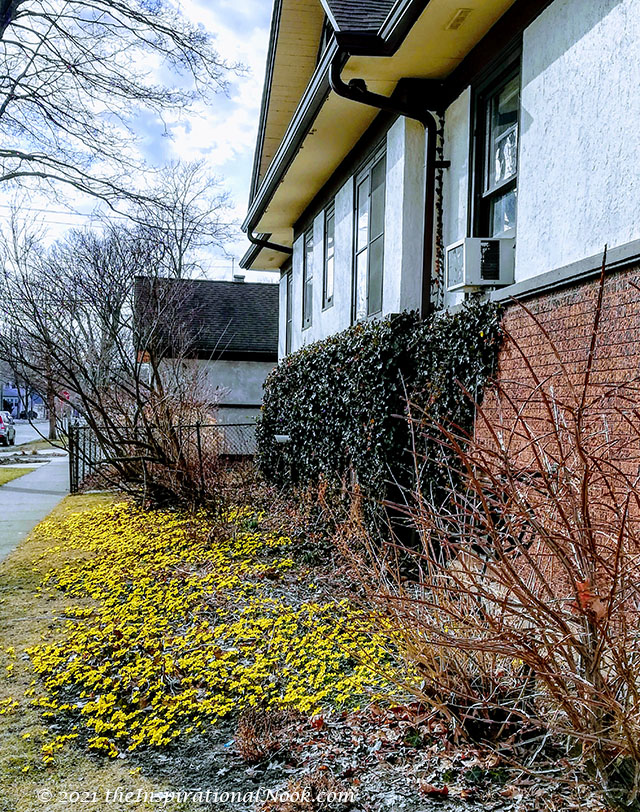Winter Aconite | Goodbye Winter, Hello Spring
Plant Winter Aconite!
These bright little yellow flowers are one of the earliest bloomers that spring up even before crocuses or snowdrops do. Often blooming while there is still snow on the ground and as early as the end of February in Zone 5 gardens, Winter Aconites are a real welcome sight in winter and a true sign that spring is right around the corner.
Inspired by my neighbor's garden bed that bursts into a yellow carpet every year in late February/ early March, I placed a large order of Winter Aconites from Van Zyverden's last Fall. These little tubers need to be planted by October, where they hibernate over winter before bursting into bloom a few months later. I was thrilled to see my Winter Aconite push up through the soil last week.
Here are a few photos of my neighbor's garden bed with mature Winter Aconite spilling out of the garden beds and into the lawn. They continue to naturalize and multiply every year, growing in little clumps.
WHAT is Winter Aconite?
Winter Aconite (Hyanthus hyemalis), from the Ranunculaceae family, are small, bright yellow, cup shaped, little buttercup like flowers that are native to Europe but also bloom well in the U.S.
WHEN does Winter Aconite bloom?
These are one of the earliest bloomer in North America, blooming in March. Sometime even blooming when there is still snow on the ground. In fact, these are considered 'late winter' bloomers and come up even before 'early spring' bloomers like crocuses and snowdrops.
They grow well in zones 3 to 7.
The flowers fade after a few days but leave attractive green foliage up to cover the muddy Spring beds.
Don't mow down the foliage or dig up the tubers after blooming. Allow the foliage to die back naturally. The foliage absorbs energy from the sun and stores moisture and food in the plant's tuber, which is used to create strong flowers for next year. Allow the foliage to become brown and wither away. Once it has become brown, you can cut down the foliage.
WHEN to plant Winter Aconite?
Fall is a good time to plant these little tubers. I planted mine in early October.
Is Winter Aconite poisonous?
Unfortunately, both the plants and the tubers are poisonous. So, if you have dogs that love to dig around in the garden, this may not be a good choice. If ingested it may cause nausea, vomitting and possibly more serious problems.
WHERE to get Winter Aconite from?
I ordered my Winter Aconite from Van Zyverden's in late September. They came sweetly packaged with good instructions on how to plant. One important consideration is if you are mail ordering winter aconite, take them out of the cardboard package and open them up as soon as you receive them. They need air circulation and should not be left in a closed box.
 |
HOW to plant Winter Aconite?
Soak tubers overnight before planting.
Dig a trench about 5 inches deep.
Line with a layer of compost and scatter the tubers into the bed for a natural look. These are little plants, only around 4 inches across, so the closer the tubers are planted the more attractive they look.
Plant the tubers around 6 inches apart so that there is enough room for them to spread out and naturalize over the years.
Squirrels love the smell of freshly dug earth and will dig up the tubers and carry them away. To prevent the bandit rodents from making off with the tubers, cover the area with some cardboard weighted down with bricks. Make sure to remove the cardboard after about a week.
WHERE to plant Winter Aconite?
- The best place to plant these little tubers are in fertile, well drained spot that will be sunny at the time of bloom. I planted mine on the south side of our house under a canopy of maple and oak trees. The leaves of these trees don't leaf out until well after these flowers have finished blooming.
- Planted en masse under large trees, at the base of shrubs, in borders, rock gardens or along pathways, these bright little beauties pack quite a punch when they flower.
- Since they flower in late winter when it's still too cold to sit outside and admire them, it's best to plant them near a window where they can be admired and appreciated from inside.
- Aconite require consistent moisture throughout the year, particularly through winter and spring.
- Leave undisturbed and they will continue to naturalize and multiply, returning with more profusion year after year.
I hope this inspires you to introduce some Winter Aconite into your garden this Fall.
To explore my other garden related posts, click on "GARDEN" below.



